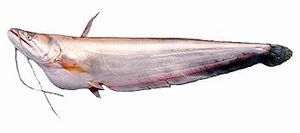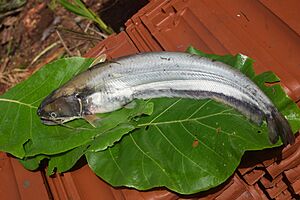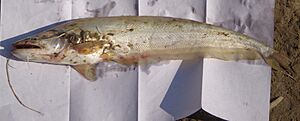Wallago attu facts for kids
Wallago attu is a type of freshwater fish called a catfish. It belongs to the family Siluridae. You can find this fish in rivers and lakes across parts of South and Southeast Asia.
This catfish lives in two separate areas, which is called a disjunct distribution. One group lives in the Indian Subcontinent, and the other lives in parts of Southeast Asia. Wallago attu can grow to be about 1.1 meters (around 3.6 feet) long.
Sometimes, people confuse Wallago attu with another similar but much bigger catfish called Wallagonia leerii. But you can tell them apart! Wallago attu has a longer, narrower head and a tall, sharp fin on its back. Wallagonia leerii has a lower, rounded back fin. Also, the eyes of Wallago attu are above its mouth, while Wallagonia leerii's eyes are at the same level as its mouth.
People in Southeast Asia have been eating this type of catfish for a very long time.
Quick facts for kids Wallago attu |
|
|---|---|
 |
|
| Conservation status | |
| Scientific classification | |
| Synonyms | |
|
Silurus boalis Hamilton, 1822 |
Contents
What is the Wallago attu?
The Wallago attu is a large catfish. It is often found in the same places as a similar fish, Wallagonia leerii. In countries like Indonesia and Malaysia, both fish are called ikan tapah. In English, they are sometimes both called "helicopter catfish."
Because they look so much alike, people often mix them up. This has led to some stories saying that Wallago attu can grow over 1.8 meters (6 feet) long and weigh more than 45 kilograms (100 pounds)! However, scientists who study fish say that Wallago attu usually doesn't grow longer than about 1 meter (3.3 feet).
The biggest Wallago attu caught by fishing rod and officially recorded weighed 18 kilograms (40 pounds). It was caught in Thailand. Some special fishing ponds claim to have even bigger ones, weighing 20 to 30 kilograms (44 to 66 pounds). So, if you hear about a much larger "helicopter catfish," it's probably a Wallagonia leerii, which can indeed grow much bigger.
Where does the Wallago attu live?
Wallago attu lives in many parts of South and Southeast Asia. But its home range is not continuous. There's a big gap between the fish living in the Indian subcontinent and those in Southeast Asia. This is a good example of a disjunct distribution, meaning the species lives in separate areas.
In the Indian subcontinent, you can find Wallago attu in all the major rivers. These include the Ganges, Indus, Narmada, Godavari, Krishna, and Mahanadi rivers. It also lives on the island of Sri Lanka. To the northwest, its range goes into Iran and Afghanistan. To the east, it can be found as far as the Irrawaddy river in Myanmar.
The second group of Wallago attu lives in Southeast Asia. This includes Thailand, Laos, Cambodia, Vietnam, Malaysia, and Indonesia. Here, it lives in rivers like the Mae Klong, Chao Phraya, and Mekong. It also lives in rivers on the Malayan peninsula and the islands of Java and Sumatra. Interestingly, it is not found on the island of Borneo.
The main area where Wallago attu is missing is between these two populations. This gap is mostly in the Salween and Tenasserim River areas in Burma. Scientists are still not sure why this fish has such a broken-up distribution.
What does the Wallago attu eat?
The Wallago attu is a large fish that hunts other animals. It mainly eats other fish. Scientists have studied what's inside the stomachs of Wallago attu from the Godavari river in India. They found that about 90 to 95% of what these fish ate was animal matter.
The small fish they most commonly eat include razorbelly minnows (Salmophasia phulo), ticto barbs (Pethia ticto), and perchlets (Chanda nama). These prey fish are all quite small, usually growing to only about 10 to 12 centimeters (4 to 5 inches) long.
Could Wallago attu be more than one species?
Because Wallago attu lives in such a huge and separated area, some scientists think it might actually be more than one species. Early studies comparing the bones of Wallago attu from Southeast Asia and South Asia have shown important differences in their skeletons.
This means that in the future, after more research, Wallago attu might be divided into two or more different species within the Wallago group.
See also
- Wallagonia leerii





